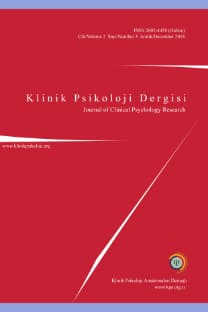Kişilerarası nörobiyoloji perspektifinden bağlanma, kaygı ve korku
Attachment, anxiety and fear from an interpersonal neurobiology perspective
___
- Ainsworth, M. D. S., Blehar, M. C., Waters, E. ve Wall, S. (1978). Patterns of attachment: A psychological study of the Strange Situation. Hillsdale, NJ: Erlbaum.
- Badenoch, B. (2008). Being a brain-wise therapist: A practical guide to interpersonal neurobiology. (Norton Series on Interpersonal Neurobiology New York: Norton & Company.
- Balbernie, R. (2001). Circuits and circumstances: the neurobiological consequences of early relationship experiences and how they shape later behaviour. Journal of Child Psychotherapy, 27(3), 237-255.
- Black, J. E. (1998). How a child builds its brain: Some lessons from animal studies of neural plasticity. Preventive Medicine, 27(2), 168-171.
- Brake, W. G., Zhang, T. Y., Diorio, J., Meaney, M. J. ve Gratton, A. (2004). Influence of early postnatal rearing conditions on mesocorticolimbic dopamine and behavioral responses to psychostimulants and stressors in adult rats. European Journal of Neuroscience, 19(7), 1863-74.
- Bowlby, J. (1973). Attachment and loss: Separation. New York: Basic Books.
- Caldji, C., Diorio, J. ve Meaney, M. J. (2003). Variations in maternal care alter GABA-sub (A) receptor subunit expression in brain regions associated with fear. Neuropsychopharmacology, 28(11), 1950-59.
- Cozolino, L. J. (2008). The healthy aging brain: Sustaining attachment, attaining wisdom. New York: Norton.
- Cozolino, L. J. (2010). The neuroscience of psychotherapy: Building and rebuilding the human Brain (2. Baskı). New York: Norton & Company.
- Doidge, N. (2007). The brain that changes itself: Stories of personal triumph from the frontiers of brain science. New York: Penguin.
- Fair, D. A., Dosenbach, N. U. F., Church, J. A., Cohen, A. L., Brahmbhatt, S., Miezin, F. M. ve ark. (2007). Development of distinct control networks through segregation and integration. Proceedings of National Academy of Sciences, 104(33), 13507–13512.
- Gönenir-Erbay, L. ve Ünal, S. (2017). Terapi beyinde ne yapar? Türkiye Klinikleri Çocuk Psikiyatrisi Özel Dergisi, 3(2), 163-168.
- Guastello, S. J., Koopmans, M. ve Pincus, D. (Ed.) (2009). Chaos and complexity in psychology: The theory of nonlinear dynamical systems. Cambridge: Cambridge University Press.
- Huttenlocher, P. R. (1994). Synaptogenesis in human cerebral cortex. New York: Guilford.
- Kornfield, J. (2008). The wise heart: A guide to the universal teachings of Buddhist psychology. New York: Bantam.
- MacLean, P. D. (1985). Brain evolution relating to family, play, and the separation call. Archieves of General Psychiatry, 42(4), 405-417.
- MacLean, P. D. (1990). The triune brain in evolution: Role of paleocerebral functions. New York: Plenum Press.
- Månsson, K., Salami, A., Frick, A., Carlbring, P., Andersson, G., Furmark, T. ve ark. (2016). Neuroplasticity in response to cognitive behavior therapy for social anxiety disorder. Translational Psychiatry, 6(2),1- 8.
- Nolte, T., Guiney, J., Fonagy, P., Mayes, L. C. ve Luyten, P. (2011). Interpersonal stress regulation and the development of anxiety disorders: an attachmentbased developmental framework. Frontiers in Behavioral Neuroscience, 5, 55.
- Porges, S. W. (2009). The polyvagal theory: New insights into adaptive reactions of the autonomic nervous system. Cleveland Clinic Journal of Medicine, 76(Suppl 2), 86-90.
- Purves, D. ve Lichtman, J. (1980). Elimination of synapses in the developing nervous system. Science, 210(4466), 153-157.
- Purves, D., Augustine, G. J., Fitzpatrick, D., Hall, W. C., LaMantia, A. ve White, L. E. (2012). Neuroscience. (4. baskı) Sunderland, Mass.: Sinauer Associates.
- Rees, S. L., Steiner, M. ve Fleming, A. S. (2006). Early deprivation, but not maternal separation, attenuates rise in corticosterone levels after exposure to novel environment in both juvenile and adult female rats. Behavioral Brain Research, 175(2), 383-391.
- Sbarra, D. A. ve Hazan, C. (2008). Coregulation, dysregulation, self-regulation: An integrative analysis and empirical agenda for understanding adult attachment, separation, loss and recovery. Personality and Social Psychology Review, 12(2), 141-167.
- Schore, A. N. (2005). Attachment, affect regulation, and the developing right brain: Linking developmental neuroscience to pediatrics. Pediatrics in Review, 26(6), 204-217.
- Siegel, D. J. (1999). The developing mind: Toward a neurobiology of interpersonal experience. New York: Guilford Press.
- Siegel, D. J. (2006). An interpersonal neurobiology approach to psychotherapy. Psychiatric Annals, 36(4), 248.
- Siegel, D. J. (2012). The developing mind: How relationships and the brain interact to shape who we are. (2. Baskı) New York: The Guilford Press.
- Uzbay, T. (2004). Anksiyete ve depresyonun nörobiyolojisi. Klinik Psikiyatri, 4(3), 1-11.
- ISSN: 2602-4438
- Yayın Aralığı: 3
- Başlangıç: 2017
- Yayıncı: Klinik Psikoloji Araştırmaları Derneği
İntihar Olasılığı Ölçeği: Gözden geçirme, geçerlik ve güvenirlik çalışması
Ayşegül BATIGÜN DURAK, Nesrin ŞAHİN HİSLİ
Kişilerarası nörobiyoloji perspektifinden bağlanma, kaygı ve korku
Dilay ELDOĞAN, Eda CENGİZ, Ezgi ERKAN, Ş. Didem KAYA, Beliz TOROSLU, Çağıl ÜNAL
Kendiliknesnesi İhtiyaçları Envanterinin Türk toplumundaki psikometrik özelliklerinin incelenmesi
Cihat ÇELİK, Hatice Gülsen ERDEN, Sevim ÖZMEN, Selma TURAL HESAPÇIOĞLU
